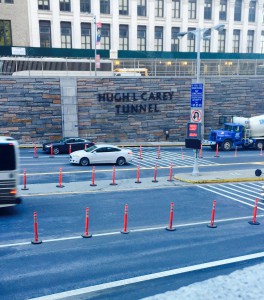This picture was taken near the Battery Tunnel which is now called “Hugh L. Carey Tunnel” It was very challenging to get this shot of this picture that I risk placing my iphone on the edge of the bridge I was standing on just so I could have zoomed in. It was a very tedious momemt for me, but it felt really accomplishing after I was done.
Hugh L. Carey, the governor who helped rescue New York from the brink of financial collapse in the 1970s and tamed a culture of ever-growing spending, died Sunday at his summer home on Shelter Island, N.Y. He was 92.
His death was announced by the office of Gov. Andrew M. Cuomo. “Governor Carey led our state during a time of great financial turmoil and pulled us back from the brink of bankruptcy and economic ruin,” Mr. Cuomo said in the statement.
From 1975 through 1982, as the state’s 51st governor, Mr. Carey led a small group of public servants who vanquished the fiscal crisis that threatened New York City and State — the direst emergency a governor had faced since the Depression — by taking on powers over the city’s finances that no governor had wielded before and none has wielded since.
Hugh Carey rose to power as a Democrat outside his party’s machine. He began the 1974 campaign for governor as a recently widowed congressman from Brooklyn, a long shot who was not taken seriously, yet he cruised to one of the most resounding victories in the state’s history.
But he spent his final years as governor frustrated. Absent an emergency, he often seemed bored with the job.
The political strategist David Garth, who was one of Mr. Carey’s closest associates, once said of him: “Hugh Carey on the petty issues can be very petty. On the big stuff, he is terrific.”
Running as a Democrat, Carey was elected to the United States House of Representatives in 1960, unseating Republican incumbent Francis E. Dorn. He served seven terms. He served on the House Ways and Means Committee and led the effort to pass the first Federal Aid to Education program. He was elected Governor of New York in 1974 and resigned his Congressional seat on December 31, 1974. Carey was reelected in 1978, serving two full terms as Governor. On January 1, 1983 he was succeeded by his lieutenant governor, Mario Cuomo. Carey then returned to private law practice with the firm of Harris Beach in New York City, where he resided until his death in August 2011. He was the first congressman from Brooklyn to oppose the Vietnam War.
Carey became the state’s first Democratic Governor in 16 years when he was elected governor in 1974, unseating incumbent RepublicanMalcolm Wilson, who had assumed the office after Nelson Rockefeller resigned in December 1973 (to work on the Commission on Critical Choices for Americans). Nationally, the 1974 election were dominated by the Watergate scandal which had destroyed President Richard Nixon‘s presidency and impacted negatively Republicans in general, making them nationally unpopular. In 1974, Democrats also recaptured the New York State Assembly.
Carey is best remembered for his successful handling of New York City’s economic crisis in the late 1970s. As Governor he was responsible for building the Jacob K. Javits Convention Center; Battery Park City; the South Street Seaport and the economic development of the NYC boroughs outside Manhattan. He also helped provide state funding for the construction of the Carrier Dome at Syracuse University. He is also remembered for preventing conservative legislators from reinstating the death penalty and preventing such legislators from taking away state abortion laws.
In 1947, Carey married Helen Owen. They became the parents of Alexandria, Christopher, Susan, Peter, Hugh, Jr., Michael, Donald, Marianne, Nancy, Helen, Bryan, Paul, Kevin, and Thomas. His wife, Helen, died of breast cancer in 1974. Peter and Hugh, Jr. died in an automobile accident in 1969. Paul, who served as White House Special Assistant to President Bill Clinton as well as 77th Commissioner of the Securities and Exchange Commission, died of cancer in 2001.
In 1981, Carey married Evangeline Gouletas, a Chicago-based Greek-American real estate mogul.[6] This marriage proved controversial and a political liability. The marriage generated controversy, since Gouletas had affirmed on the marriage license that she had two ex-husbands, when she actually had three. Gouletas also said that her first husband, with whom she had a daughter, was dead, but he was still alive at the time. The marriage also caused trouble for Carey with the Catholic Church, since he married a thrice-divorced woman in a Greek Orthodox Church. Carey and Gouletas-Carey divorced in 1989.[7] Carey later described this marriage as “his greatest failure.”[8]
Carey died surrounded by his family on August 7, 2011. He was at his summer home on Shelter Island, New York.[9]
http://en.wikipedia.org/wiki/Hugh_Carey





Wow, tunnels are funny places – some people are terrified of driving through them and here in the city, there are usually long waits to access them. I wonder whether this is a great honor or not….
Where exactly is this tunnel?